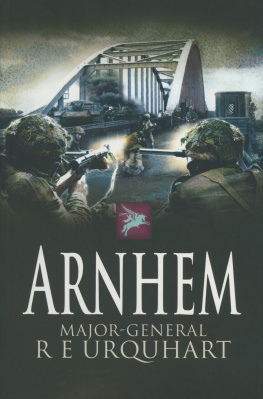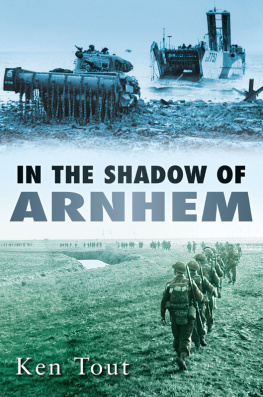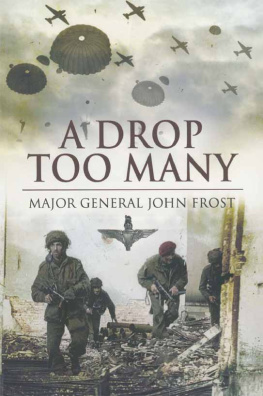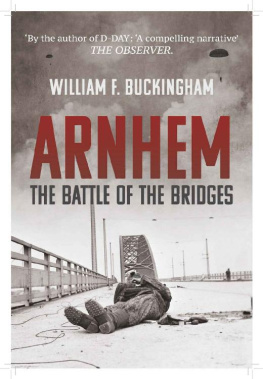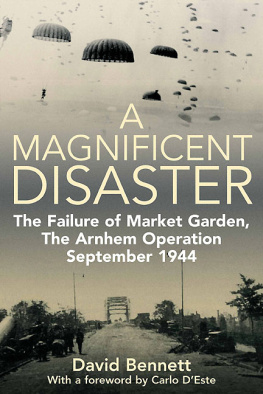
For Shubbs, devoted brother of Anthony Cotterell, who contributed so much to this book but sadly did not live to see it published.
One could only understand Anthony at all well by keeping always in mind that he was a writer. He was that more than anyone I ever met.
Ernest Watkins, autobiography
The battle for Arnhem contains all the ingredients of a classical tragedy, both from a civilian and military point of view.
Piet Kamphuis, Holland at War Against Hitler
T his book would not have been possible in this form without the involvement of Geoffrey Cotterell, Anthonys brother. When I first got to know him, Geoffrey was in his late eighties and had had a major operation to replace his hip, yet during the course of the next two years we enjoyed two phenomenally successful research trips to Holland together. Geoffrey gave me many photographs and all the surviving Cotterell family documents which related to Anthony. The latter included not only the incredible sequence of letters which Geoffrey wrote to his mother in 194546, and those between his mother and his aunt Jane of the same period, but also all Anthonys surviving unpublished typescripts, including the wonderful D-Day and Normandy material.
Geoffrey, a novelist who had had a string of best-sellers in the first twenty-five or so years after the war, took a huge interest in the projected book. He had a phenomenal memory, and what he told me about the search for Anthony was invariably verified when that particular facet of the search was covered by official documents. This was also the case with his correspondence with his mother in 194546. It is obvious that he was always truthful and scrupulously accurate with her, never hiding the worst potential explanations for Anthonys disappearance.
The trips to Holland included exciting, amusing and, occasionally, rather harrowing times. The most moving experience of all was visiting No.12 Rozenhoflaan, the house in Zutphen in which Anthonys wounds had been medically treated just before he vanished forever. After we got back to England, Geoffrey sent me the following email:
Re my impression of Rozenhoflaan I did send you an email which Ive just failed to find under sent, so just possibly it didnt get to you. I know what I said was similar to your own feelings, that there is a tremendous atmosphere, I said like the feeling you have when you enter an old enormous cathedral, full of immanence and history, with the space on the right of the front door a special very holy chapel, and I thought of Tone there being a sort of Christ figure from many an old master oil painting, down from the cross and attended by Mary etc. And looking towards the second door on the left, amazed that it was all just as Tannenbaum had described it to me. And therefore real. A haunted, awesome place.
Geoffrey had never ceased to grieve deeply over the loss of his brother, and even in old age still felt responsible for never having managed to find him or discover his fate. In his eighties, he once again began to make enquiries in Holland, hoped that perhaps the passage of time and the opening up of archives might shed light on Anthonys disappearance. When I joined forces with him, I also had great hopes that I might solve the mystery, but a mystery it remains. I greatly regret this, but most of all I am sad that Geoffrey did not live to see this book published, one to which he contributed so much.
I would also especially like to thank Frits and Jeanne Slijkoord, who not only made the trip to No.12 Rozenhoflaan possible but also gave many details of life under the Occupation in Holland. Frits with great kindness translated some Dutch documents for me and helped in numerous other ways. Jeanne was the most invaluable eyewitness; as a child, she had seen the shooting in Brummen marketplace, and the horror of that event had made an indelible impression upon her.
An equally important helper in Holland has been Bob Gerritsen. Bob has an unrivalled knowledge of the battle of Arnhem and a stupendous archive of material, all of which he shared with me with the most perfect generosity, simply in the interests of establishing the truth. Several of the photographs in this book were sourced by Bob, including the astonishing picture of the British prisoners in Saint Eusebius in Arnhem. Bob thoroughly read the manuscript of this book and made many detailed and helpful comments. Bob also helped Geoffrey a great deal when Geoffrey first opened up the new enquiries about Anthony at Arnhem.
I owe a great deal to a number of other Dutch people. The owners of No.12 Rozenhoflaan, Rene Schepers and Renske Boersma, could not be there when we visited due to a sudden death in the family. However, with the greatest kindness they did not cancel the visit, but instead asked a kind neighbor to show us round their house.
I also owe a debt to Ymi Ytsma whose father-in-law, Police Detective Jan Arend IJspeerd of the Almelo Investigation Department, had been involved in the search for Anthony in 194546. Ymi shared with me the Kamp documents from The Hague and other material relevant to the search.
I would like to thank the following: Dick Schlter of the Airborne Museum, Oosterbeek; Dirk Jan Dolfing of the Regionaal Archief, Zutphen; Adrie Roding of the Stadsarchief Enschede; and Ton Wientjen, a historian living at Enschede, who checked the Dutch archives to make sure that I had not missed vital information about Anthonys disappearance. Ton also read the manuscript and made very helpful comments.
I must not leave out Wim Brekveld, who did such a marvellous job of driving me and Geoffrey around Holland, and who helped to make our two trips so enjoyable.
So far as English helpers are concerned, my grateful thanks go to Tony Hibbert, not only for talking to me at length about Anthony and Arnhem, but also for giving me a copy of his Arnhem and post-Arnhem diaries and allowing me to quote extensively from them. Another great source of information was Jim Flavell, who shared with me his memories of Arnhem and the paratroopers.
Roy Hemington at the Commonwealth War Graves Commission gave invaluable information about the British prisoners graves at Enschede. Rosemary Mcgrath, Anthony and Geoffreys cousin, filled in details of the family background. Graham Page, who is writing a biography of Barbara Skelton, notified me of the fascinating connection between Barbara and Anthony, revealed in her diaries. I thank them all.
I would also like to thank the following: Mark Hickman of the Pegasus Archive for helping with my enquiries and for permission to quote from the Pegasus Archive website, including the 1st Airborne Reconnaissance Squadron war diary (Crown Copyright). Thanks also go to Simon Middleton-Briggs for sharing Bernard Briggs document of the British prisoners wanderings after the shooting at Brummen; Kevin Bending, who helped identify the RAF station from which Anthony flew in December 1943 as Woodhall Spa; and Fred Preller, Webmaster for 384th Bomb Group in the Second World War, who supplied documents relating to Anthonys flights with the 8th Air Force on bombing missions.
The Robert Graves connection to Anthony, through his daughter Jenny Nicholson, was a rich source of information. I would like to thank Caroline Shaw, the archivist at the St Johns College Robert Graves Trust, and Lucia Graves, Sam Graves, and Richard Graves. A useful letter from Anthony to Robert Graves also surfaced in the Robert Graves archive of the Poetry Collection, the University of Buffalo, and I thank James Maynard, the assistant curator, for finding it.
An incredibly rich seam of knowledge was found in the University of Calgarys Special Collections, where Ernest Watkins papers are deposited. Watkins knew Anthony extremely well because he worked with him at WAR for two years. Having the greatest admiration for Anthony, he wrote extensively about him and their work for ABCA in his unpublished autobiography. I would like to thank Ernest Watkins sons, Tim and Nick, for permission to quote from their fathers writings, and for the picture of Ernest on his motorbike in Iceland. I would also like to thank the archivist Apollonia Steele of the Special Collections, for her great help in tracking down the relevant material.
Next page


